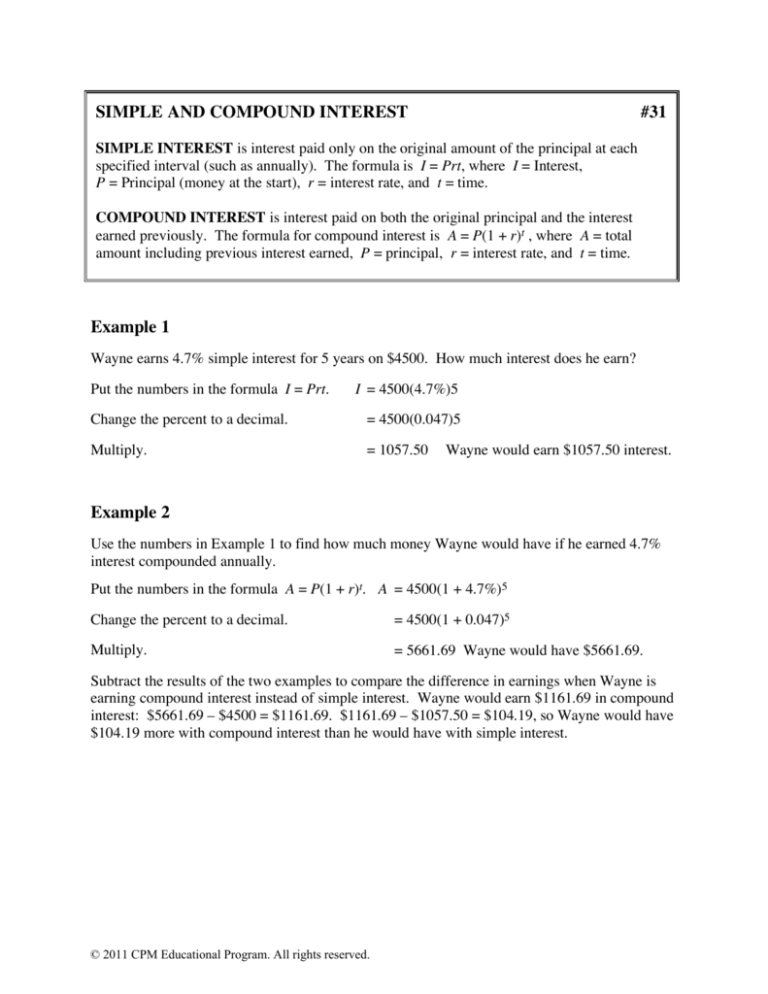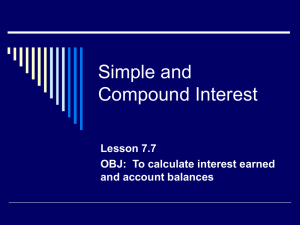
SIMPLE AND COMPOUND INTEREST
#31
SIMPLE INTEREST is interest paid only on the original amount of the principal at each
specified interval (such as annually). The formula is I = Prt, where I = Interest,
P = Principal (money at the start), r = interest rate, and t = time.
COMPOUND INTEREST is interest paid on both the original principal and the interest
earned previously. The formula for compound interest is A = P(1 + r)t , where A = total
amount including previous interest earned, P = principal, r = interest rate, and t = time.
Example 1
Wayne earns 4.7% simple interest for 5 years on $4500. How much interest does he earn?
Put the numbers in the formula I = Prt.
I = 4500(4.7%)5
Change the percent to a decimal.
= 4500(0.047)5
Multiply.
= 1057.50
Wayne would earn $1057.50 interest.
Example 2
Use the numbers in Example 1 to find how much money Wayne would have if he earned 4.7%
interest compounded annually.
Put the numbers in the formula A = P(1 + r)t. A = 4500(1 + 4.7%)5
Change the percent to a decimal.
= 4500(1 + 0.047)5
Multiply.
= 5661.69 Wayne would have $5661.69.
Subtract the results of the two examples to compare the difference in earnings when Wayne is
earning compound interest instead of simple interest. Wayne would earn $1161.69 in compound
interest: $5661.69 – $4500 = $1161.69. $1161.69 – $1057.50 = $104.19, so Wayne would have
$104.19 more with compound interest than he would have with simple interest.
© 2011 CPM Educational Program. All rights reserved.
Problems
Solve the following problems.
1.
Tong loaned Jody $70 for a month. He charged 5% simple interest for the month. How
much did Jody have to pay Tong?
2.
Jessica’s grandparents gave her $5000 for college to put in a savings account until she
starts college in four years. Her grandparents agreed to pay her an additional 6.5% simple
interest on the $5000 for every year. How much extra money will her grandparents give
her at the end of four years?
3.
David read an ad offering 7 4 % simple interest on accounts over $1500 left for a minimum
of 5 years. He has $1500 and thinks this sounds like a great deal. How much money will
he earn in the 5 years?
4.
Javier’s parents set an amount of money aside when he was born. They earned 5.25%
simple interest on that money each year. When Javier was 15, the account had a total of
$1181.25 interest paid on it. How much did Javier’s parents set aside when he was born?
5.
Kristina received $125 for her birthday. Her parents offered to pay her 4.25% simple
interest per year if she would save it for at least one year. How much interest could
Kristina earn in a year?
6.
Kristina decided she would do better if she put her money in the bank for one year, which
paid 3.75% interest compounded annually. Was she right?
7.
Suppose Jessica (from problem 2) had put her $5000 in the bank at 2.85% interest
compounded annually. How much money would she have earned there at the end of the
4 years?
8.
Mai put $3750 in the bank at 3.87% interest compounded annually. How much was in her
account after 7 years?
9.
What is the difference in the amount of money in the bank after five years if $3500 is
invested at 3.4% interest compounded annually or at 2.8% interest compounded annually?
10.
Elizabeth was listening to her parents talking about what a good deal compounded interest
was for a retirement account. She wondered how much money she would have if she
invested $2000 at age 20 at 2.8% interest compounded quarterly (four times each year) and
left it until she reached age 65. Determine what the value of the $2000 would become.
11.
Elizabeth decided to try another problem. If she invested $2500 at age 25 at 2.65% interest
compounded quarterly, how much would it be worth when she reached age 65?
12.
Compare your answers for problems 10 and 11. What are your conclusions?
1
© 2011 CPM Educational Program. All rights reserved.
Answers
1.
I = 70(0.05)1 = $3.50; Jody paid back $73.50.
2.
I = 5000(0.065)4 = $1300
3.
I = $1500(0.0725)5 = $543.75
4.
$1181.25 = x(0.0525)15; x = $1500
5.
I = 125(0.0425)1 = $5.31
6.
A = 125(1 + 0.0375)1 = $129.69; No, for one year she needs to take the higher interest
rate if the compounding is done annually. Only after one year will compounding outstrip
simple interest.
7.
A = 5000(1 + 0.0285)4 = $5594.83
Jessica would have earned $594.83.
9.
A = 3500(1 + 0.034)5 – 3500(1 + 0.028)5 = $4136.86 – $4018.22 = $118.64
8.
A = 3750(1 + 0.0387)7 = $4891.73
10.
A = 2000(1 + 0.028)180 (because 45 · 4 = 180 quarters) = $288,264.15
11.
A = 2500(1 + 0.0265)160 (because 40 · 4 = 160 quarters) = $164,199.79
12.
You should see that the number of years is an important factor when interest is
compounded.
© 2011 CPM Educational Program. All rights reserved.










